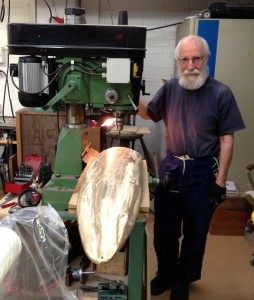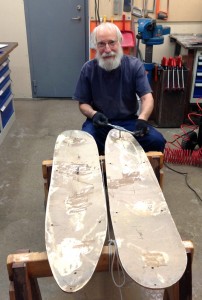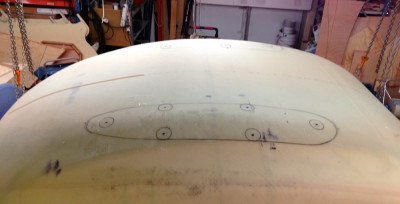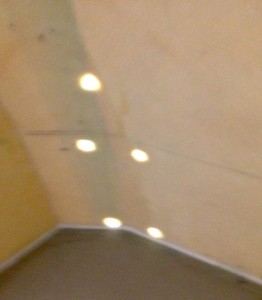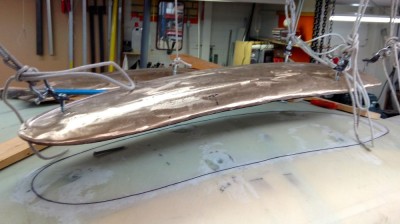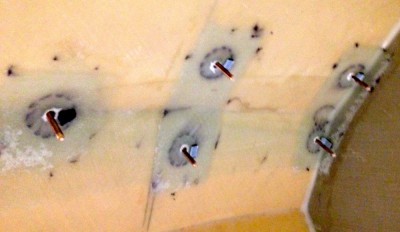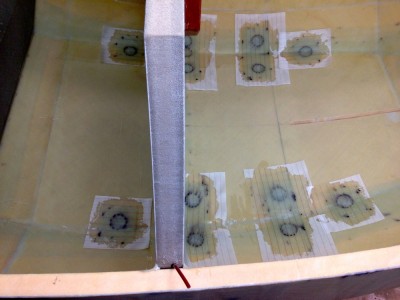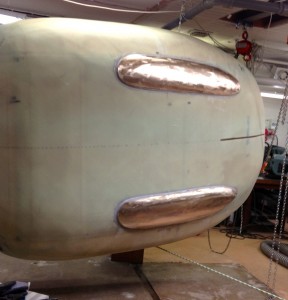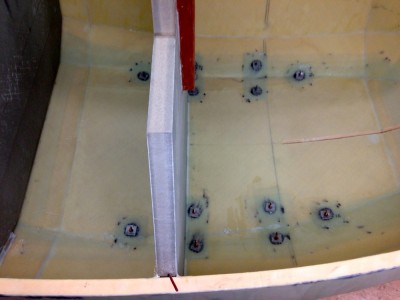The bronze soles are now sequrly in place . They are there to protect the bottom when the boat takes the ground and is being transported. They are ground plates for the lightning conductor. They do duty as ballast and they are antifouling.
It is good to have them in place but the job has taken longer than anticipated. To handle reality one is always simplifying it. Like a map if it shows to many details it just becomes confusing but this also means tha it is diffucult to estimated how much time is needed to finish the job. No problem with me I take the needed time to do a good job and I enjoy it. Building boats and sailing them in deep water that is what makes life worth living.
This time I made more mistakes than usual. By definition ballast is heavy. Each sole weighs 53 kilos or 117 pounds. When I was younger it was no problem to lift that wheight, not more than a girl and I could handle them alright. I can still lift 53 kilos. The problem now is that the next day I might get pain in my back. Freindly people in the building helped me to do the lifting but I did not want to take to much of their time and hurrid.
There are two ways of fitting the keel bolts, before or after placing the soles on the boat. If you put the soles on the boat first you do not have to worry about if the bolts are parallell to each other. On the other hand I had decided to embed the soles in elastic NM-epoxi and the epoxi has to come on before the soles and once you add the hardener the clock starts to tick therefore you want everything to go in a hurry. Parallell keel bolts it had to be.
The holes in the soles for the bolts had to be drilled on a co-ordinate table. The travel of my co-ordinate table is 50 cm but the soles are 120 cm long. To overcome that problem I screved them on a 5 cm thick particle board. that way I could slide them on the co-ordinate table and extend its range, just. As a man was waiting for me I was in a hurry and mist one out of six holes. It took longer. I got even more confused and missed a marking on the second on now the hole came just at the bulkhead. Bad luck would have it so that the pilot drill missed the reenforcement and was bent and stuck in the hull. I tried every trick. I even whent and bougt an LPG-burner and heated the drill intill it was red hot. It was a 3.5 millimeter long thin drill and the heat did not penetrate the 50 mm thick solid glassfibre. After a while it broke. Finally I succeded in drilling it out. Now I had six holes in the wrong place. I had to lift of the bronze and plug the holes. Put the bronze back and drill new holes in the correct position. The thing is not to lose patiens and the good mood.
I did not sin by making errors. Sin is to continue to walk on a road that leads astray. Once I find myself on the wrong way I must turn back and find the good road. Then everything is forgiven. Because I realise that if I quickly and consistently discover and correct errors then in the end I will have a good boat I do not lose patience but correct mistakes.
Below follows some pictures. Click once or twice to enlarge.
Abowe. The sole on the co-ordinate table. The particle board that made me able to slide it so that I could get all the holes parallell can be seen.
Abowe tapping the holes using 3/8 UNC for the bolts. I had imported them from Topplicht in Germany.
Above. The position of the holes are marked. After that I remowed the core. Filled it with glassfibre flock and injected epoxi. A insex key on a powefull drill was used to get under the outside skin. Big forces was generated Divinycell H 100 is very though and strong. One six mm key bent like a cork-screw, 8 mm was strong enough.
Above: The core is remowed. Next stepp filling lassfibre flock with a pair of tweezers and injecting epoxy.
Above: By hanging the sole above the holes and lowering it parallell to the hull the bolt came into place nicely after a few tryes, dry runs.
Above: The keel bolts from the inside. They are that long because the elastic epoxy has a very high viscosity and the surface is very big. The sole has to be screwed down and aftertightend during several houers.
Above: The inside laminate is reenforced. Peel ply is used to get a good surface.
Abowe: The job is done and I can be proud. When turning the boat back on even keel I had to be careful. The center of gravity is now much lower and the boat had a tendency to flip over. If cought under the boat I might get badly hurt or even irreparably damaged. To avoid that a the rope below the boat is there to restrain the mowement.
Above: To spread the load I use 50 x 50 x 3 mm washers. I have not desinged this system to be sufficciently strong but for maximum strenght. Thats the way I like it. You never know when the unexpected arrivies. Then I am prepared. It makes for good sleaping to know that you have done everything and you also feel proud.
To be continued…
Regards Yrvind.

